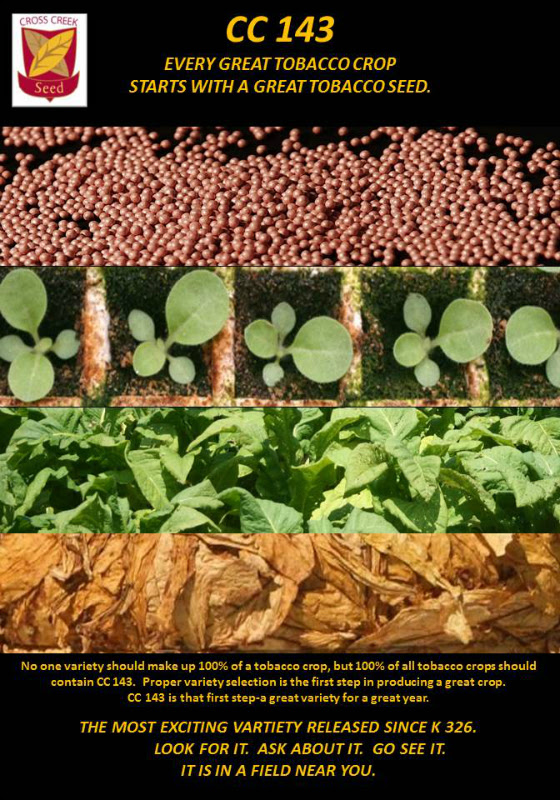
The flue-cured crop in the Southside of Virginia was coming off well as the second full week of September began. This crew was harvesting on the David Buchanan farm near Skipwith, just north of the border with North Carolina.
FLUE-CURED
VIRGINIA--This was one year when it really paid to irrigate in the Southside. "It was beautiful for a while but it turned off dry," says Keith Brankley of Skipwith. "We are irrigating now to keep it from burning up in the field." He expects yield will fall short of average, but the heat wasn't the main culprit. "We may be five to 10 percent short on pounds, because we had
 | ||
|
a lot of spots that got too much water." Green color from sunbaking isn't helping either. His brother-in-law and neighbor, David Buchanan, has passed the halfway point on harvest (see photo above). He is optimistic he will finish the first week of October, but many of his neighbors in Mecklenburg County have much farther to go. An early killing frost could cause real damage. In Lunenburg County, just north of Skipwith, heat is still the problem. "We've had some cooler days here and there, but it is still hot and dry overall," says Lindy Tucker, Extension agriculture agent. In adjacent Brunswick County, 'dry, humid and hot' best described the weather last week, says Cynthia Gregg, Extension agriculture agent. "Tobacco is yellowing quickly in the fields." USDA estimated that 52 percent of Virginia flue-cured had been harvested by the beginning of this week.
One way to cut curing costs: Buchanan bought a solar curing barn for this season, and the results have been good. "It is a Long Solar Eagle, and it uses a built-in solar collector to save fuel," he says. "It yellows more evenly due to heat from the collector on the top and sides. It seems I save about a day in curing." Long of Tarboro, N.C., will have Solar Eagles to sell this fall. "The Solar Eagle reduces fuel cost by 'actively' drawing fresh air for curing through the barn's integral solar collector where it is pre-heated before it reaches the barn's heat exchanger," says Bob Pope, general manager of Long Tobacco Barns. "This reduces the load on the barn's gas-fired burner, whether it be propane or natural gas." The barn's solar collector also transfers heat 'passively' to the curing chamber by direct conduction through its collector plate. Pope notes that a federal tax credit is available that reduces the cost of the Solar Eagle to less than that of a standard barn. For more information, call Long at 252 641 4796.
SOUTH CAROLINA--Much of the state's tobacco received heavy rains as a result of Hurricane Hermine. In Horry, S.C.'s largest leaf county, six+ plus inches of rain fell on September 2. The rain was needed but it brought harvest to a halt for much of last week. USDA estimates that about seven percent of S.C. tobacco remains to be picked.
NORTH CAROLINA--Tropical storm rains were a welcome event where they fell at the beginning of September. "Tobacco was in dire need of moisture," says Don Nicholson, N.C. Department of Agriculture regional agronomist. "There was little damage from the winds accompanying the storm." But conditions were so dry that more rain is direly needed now, he adds... Tobacco has matured earlier than normal in Harnett County this year and is not holding well, says Brian Parrish, county Extension agent. "Farmers are stripping tobacco fields, and this is putting pressure on the limited barn space available." Harvest will likely be finished by or before the end of September, he says...In Oxford, stripping of the remaining crop will probably begin next week, says Carl Watson, tobacco research specialist with the N.C. Department of Agriculture tobacco research station there. "The tobacco is deteriorating from all the sunshine"...USDA estimates that 73 percent of N.C. flue-cured has been harvested.
BURLEY
KENTUCKY--Farmers had harvested 57 percent of the crop by September 11, according to USDA. "Farmers have concerns over labor shortages for harvesting tobacco, as well as disease impacts and resulting weights," it added.
TENNESSEE--Hot and dry conditions last week allowed farmers to make great head-way with harvest, USDA reported. Tobacco producers cut an additional 16 percent more tobacco since last week with nearly half the crop now harvested. "Almost all of my tobacco producers are either done cutting or have started and close to finishing up," says Keith Jacob Boone, Extension agent in Hancock County in upper east Tennessee.
NORTH CAROLINA--About 50 percent of the burley crop in Yancey County in western N.C. had been cut by September 11, says Stanley Holloway, county Extension agent. For the state as a whole, USDA estimated that 34 percent had been harvested, well below the five-year average of 57 percent.
VIRGINIA--Burley harvest is well under way in Scott County in southwest Virginia. County agent Scott Jerrell said that through September 6, the crop appeared average... In nearby Grayson County, last week was a great week for harvest activities thanks to the lack of rain and hot temperatures, says county Extension Kevin Spurlin.
In other tobacco news...
Projections hold steady: USDA released its September projection of tobacco production on September 12. The volumes projected have changed only slightly for flue-cured and less than three percent for burley since the previous projection, on August 12.
- Flue-Cured: The September projections for the individual states are all the same or substantially the same as August's except for South Carolina, which is down 2.2 million pounds. The projection for all states is 474.1 million pounds, down 2.3 million pounds from a month ago.
- Burley: The two leading states have declined since the August estimate by five million pounds-three million in Kentucky and two million in Tennessee. Pennsylvania increased slightly and Virginia and North Carolina were roughly the same. No other burley state participates in USDA surveys. The projection for these states is 145.7 million pounds, down 4.2 million pounds from a month ago.
- Fire-Cured is down 2.5 million pounds from a month ago at 45.9 million pounds;
- Dark Air-Cured is down 1.2 million pounds at 13.3 million pounds;
- Pennsylvania Seedleaf is slightly above the last estimate at 3.8 million pounds;
- Southern Maryland is unchanged from last month, also at 3.8 million pounds.


















